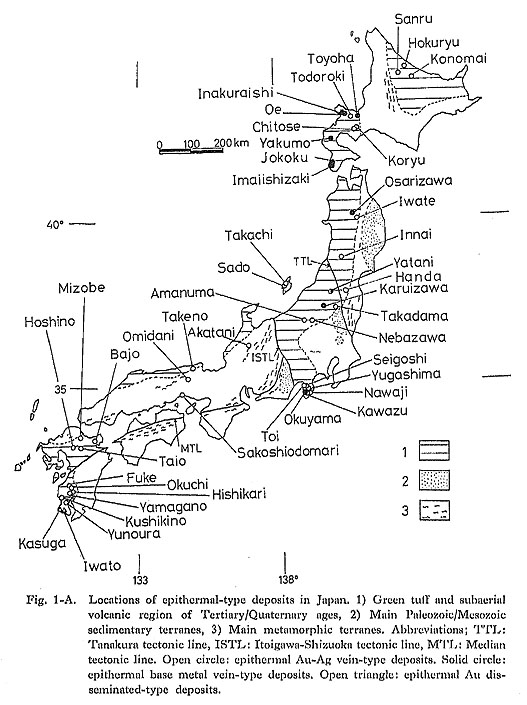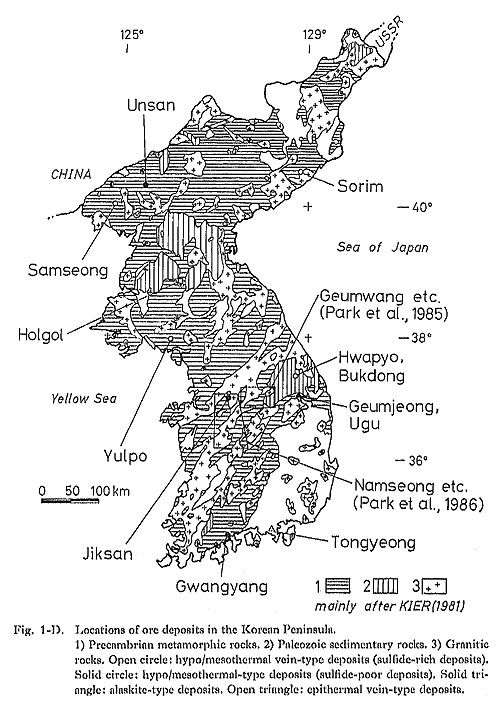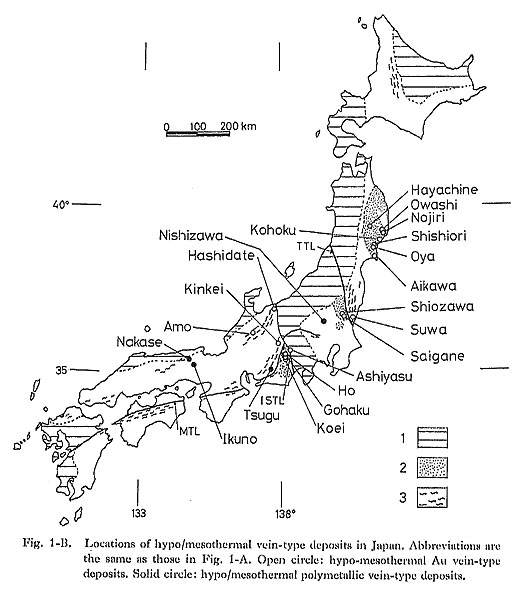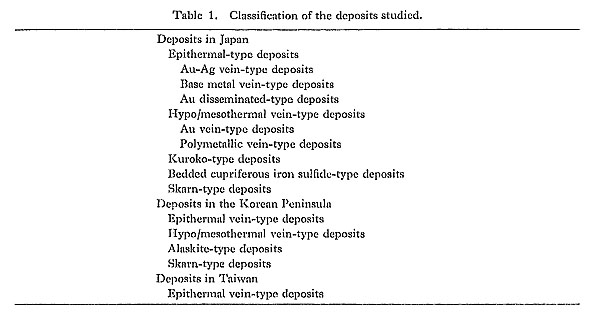CHAPTER II
General Outline of Deposits Studied
|
In general, classifying Au-Ag deposits is not easy, and there are several ways to undertake the classification. In this paper, the deposits studied are classified by combination of form of deposit, kind of metal produced and physicochemical condition of ore deposition. The locations of the ore deposits studied are shown in Fig. 1. The deposits studied can be divided into six types: (1) epithermal-type, (2) hypo/mesothermal vein-type, (3) Kuroko-type, (4) cupriferous bedded iron sulfide-type (or Bcsshi-type), (5) skarn-type, and (6) alaskite-type. 1. Epithermal-Type Deposits1) Deposits in JapanAlmost all cpithermal-type deposits occur in Tertiary-Quaternary volcanic regions (Fig. 1-A). Ages of mineralization (except for the Akatani, Sakoshi-Odomari, and Omidani deposits) are 15 to 1 Ma (Shikazono, 1985a). Epithermal-type deposits can be divided into three subtypes based on the form of deposits and kind of metal produced: Au-Ag vein-type, base metal (Cu, Pb, Zn, Mn) vein-type, and An disseminated-type. Epithermal-type deposits have been studied by many investigators. For example, Nakamura and Hunahashi (1970) summarized geological characteristics, and Shikazono (1974a, b, c, 1978b, 1985b), Hattori (1975), Takcuchi and Shikazono (1984), and Shikazono and Takeuchi (1984) estimated physicochemical environments. Epithermal Au-Ag vein-type deposits occur widely in the Japanese Islands (e.g., Northeast Hokkaido, Southwest Hokkaido, Northeast Honshu, Sado Island, Izu Peninsula, Kyushu) (Fig. 1-A). The deposits occur in young (Quaternary and Tertiary) aubaerial volcanic regions and in submarine-altered volcanic regions (so-called Green tuff region). These deposits are prineipal gold and silver producers in Japan. They are characterized by "ginguro", which means an aggregate consisting of electrum, Ag minerals (argentite, acanthite, polybasite, pyrargyrite, pearceite, naumannite, aguilarite, hessitc) and common sulfide minerals (sphalerite, galena, pyrite, chalcopyrite). Ginguro bands are alternated with fine-grained quartz bands, Pyrite is the most dominant iron mineral in the ginguro ore. Hematite, which precipitated in a late stage of mineralization, is occasionally observed, but magnetite and pyrrhotite are usually absent. Principal gangue minerals in the epithermal Au-Ag vein-type deposits are quartz, chalcedonic quartz, Mn carbonates, calcite, adularia, mixed layer clay minerals (interstratified chlorite/smectite, sericite/smectite), smectite and sericite (Nagasawa, 1981; Shikazono, 1985c). Vuggy, comb, cockade, and brecciated textures arc commonly recognized in the vein. Deposits of this type have been studied by many investigators, For example, Matsukuma (1962) and Nishiwaki et al. (1975) classified them into several subtypes by the Au-Ag mineral assemblage. Urashima (1974) described the general characteristics of the deposits. Shikazono (1985a, b, 1986) summarized opaque and gangue minerals and estimated physicochemical environments prevailing during the ore deposition.
Epithermal base metal vein-type deposits are distributed in the Green tuff region (South-west Hokkaido, Northeast Honshu) (Fig. 1-A). They are characterized by abundant occurrences of sulfides (chalcopyrite, pyrite, sphalerite, galena) but are commonly recognized as being poor in Au minerals. Ag minerals (e.g., argentite, pyrargyrite, polybasite) are commonly recognized. Pyrrhotite, magnetite, hematite, and marcasite are occasionally observed. Principal gangue minerals are quartz, chlorite, Mn carbonates, calcite, siderite, and sericite (Shikazono, 1985c). Vuggy, comb, cockade, banding and brecciated textures are commonly recognized in these veins. Detailed mineralogical and geochemical characteristics of epithermal base metal vein-type deposits have been described, for example, by Shikazono (1985b). Epithermal Au disseminated-type deposits are located at the southernmost part of Kyushu (Fig. 1-A). Very fine-grained electrum is disseminated in highly silicified rocks, Sulfide minerals are found only in small amounts. Hematite, goethite, and native sulfur are common in the silicified rock, Luzonite, enargite, and chalcocite are rarely observed. The ore body is enveloped by advanced argillic and argillic alteration zones. Geological and mineralogical descriptions on deposits of this type have been presented by Urashima et al. (1981a). Take-nouchi (1983) did a fluid inclusion study. 2) Deposits in the Korean PeninsulaEpithermal Au-Ag vein-type deposits are rare in the Korean Peninsula. The only epithermal-type deposit studied is the Tongyeong, which is in the southern end of the Korean Peninsula (Fig. 1-D). The deposit is hosted by late Cretaceous andesitic rocks and quartz porphyry (Park, 1983), Sulfide minerals (pyrite, chalcopyrite, sphalerite, galena, tetrahedrite, Cu-Ag sulfides) are abundant. The main. gangue minerals are rhodochrosite and quartz.
3) Deposits in TaiwanThe only deposits studied are the Chiufen and Chinkuashih (Fig. 1-E). They occur in Tertiary volcanic and sedimentary rocks and can be classified as epithermal (Sakazaki et al., 1963, 1964a, b; Otagaki, 1970). Theae deposits are characterized by extensive ailicification and alunitization that preceded the Au-Ag mineralization. Main sulfide minerals are luzonite and enargite.
2. Hypo/Mesothermal Vein-Type Deposits1) Deposits in JapanDeposits of this type occur in sedimentary and volcanic terrane with felsic plutonic activities and in regionally metamorphosed rocks (Fig. 1-B). The age of the formation is considered to be Cretaceous and middle Tertiary, based on the geological occurrences and K-Ar dating data. The ore deposits are occasionally associated with granitic rocks, but they are usually not hosted by granitic rocks. This type of deposit can be divided into two subtypes: Au vein-type and polymetallic vein-type. General descriptions of the deposits can be found, for example, in Watanabe (1936) and Nakamura and Miyahisa (1976). Physicochemical environment (aS2, aO2, temperature) has been. estimated by Nedachi (1974) and Shikazono and Shimizu (1987).
Hypo/mesothermal Au vein-type deposits occur in sedimentary rocks (mainly black shale) and in regionally metamorphosed rocks (Fig. 1-B). The deposits occurring in the sedimentary rocks are mainly in three districts: Kitakami, Yamizo, and Koma. The few deposits in the metamorphic region are the Suwa, Kinkei, Amo, and Hashidate. Hypo/mesothermal Au vein-type deposits have been found closely related to Cretaceous granitic activities (e.g., in the Kitakami district). The deposits occur rarely in felsic volcanic rocks (e.g., the Kohoku deposit). Those in the Yamizo and Koma districts occur in sedimentary rocks (mainly black shale) and are not associated with granitic rocks. In these deposits, small amounts of galena and pyrite are scattered in the quartz veins, but few amounts of sulfide minerals are found. In several deposits in the Kitakami district, however, such as the Kohoku deposit, abundant sulfide minerals occur (Nedachi, 1974). Principal sulfide and gangue minerals from deposits of this type are pyrrhotite, pyrite, chalcopyrite, arsenopyrite, quartz, chlorite and dolomite. Yamaoka (1981) and Nedachi (1974) have carried out the mineralogical studies, and a few geological and geochemical studies are available. The polymetallic vein-type deposits studied include Nishizawa, Ikuno, Tsugu, and Nakase. These deposits have produced Sn, W, Cu, Pb, Zn, Hg, Sb, Au, and Ag, and occur in felsic and andesitic volcanic rocks of the Cretaceous and Tertiary ages (Fig. 1-B). They are characterized by vertical telescoped ore zoning and contain large amounts of sulfide minerals (sphalerite, chalcopyrite, galena, pyrite, pyrrhotite, arsenopyrite, stibnite). Common gangue minerals are quartz, calcite, siderite, dolomite, chlorite, sericite and fluorite. Tatsumi (1948), Nakamura (1970), and Nakamura and Miyahisa (1976) are among those who have studied deposits of this type. 2) Deposits in the Korean PeninsulaHypo/mesothermal vein-type deposits are widely distributed in the Korean Peninsula (Fig. 1-D) and are the most common type of deposit. It is the major gold producer of the Korean Peninsula and is commonly known as the Korean-type deposits (e.g., Tsuchida, 1944). The deposits occur in Precambrian gneiss and Phanerozoic sedimentary rocks and are frequently associated with Jurassic and Cretaceous granitic rocks. The ages of formation of some deposits in the Republic of Korea are estimated by K-Ar age-dating data(Shimazaki et al., 1986; Park et al., 1986) to be Jurassic to Cretaceous. The amounts of sulfide minerals in the deposits vary widely. Sulfide minerals are abundant in some deposits (e.g., Jiksan, Gwangyang, Bukdong, Unsan), but are scarce in others (e.g., Sorim). Principal sulfide and gangue minerals are pyrite, arsenopyrite, sphalerite, galena, chalcopyrite, pyrrhotite, quartz, muscovite, K-feldspar (adularia), calcite, plagioclase, and ankerite (Kaneda et al., 1986).
3. Kuroko-Type DepositsKuroko-type deposits are stratabound polymetallic sulfate-sulfide deposits (e.g., Sato, 1974). The age of formation of these deposits is well established to be 14±2 Ma from K-Ar age and paleontological data (Tanimura et al., 1983; Kaneoka, 1983). They occur mainly in altered felsic volcanic rocks in the Green tuff region (Fig. 1-C) and are characterized by gypsum ore, siliceous ore, yellow ore, black ore, barite ore, and ferruginous chert in the ascending order. Principal minerals in each ore zone are gypsum and anhydrite (gypsum ore); quartz, chalcopyrite, and pyrite (siliceous ore); chalcopyrite and pyrite (yellow ore); sphaleritc, galena, and barite (black ore); barite (barite ore); hematite and quartz (ferruginous chert). Au-Ag minerals (electrum, polybasite, argentian tetrahedrite) occur mainly in the black ore zone dominantly composed of sphalerite, bornite, galena, and barite. However, in the Nurukawa deposit, electrum occurs in the siliceous ore (Yamada et al., 1987). Extensive studies on deposits of this type have been carried out and are summarized in Tatsumi (1970), Ishihara (1974), Ohmoto and Skinner (1983), and Horikoshi (1983). Matsukuma (1985) has described the mode of occurrence of electrum.
4. Skarn-Type Deposits1) Deposits in JapanDeposits occur mainly in Cretaceous felsic volcanic and plutonic regions (Fig. 1-C), and some have been genetically related to Tertiary plutonic activity. Au-rich skarn-type deposits are intimately associated with magnetite-series granitoids defined by Ishihara (1977) (Shima-zaki, 1980). Electrum from the Kamaishi, Chichibu, and Tsumo deposits has been analyzed. Cu and Fe have been produced from the Kamaishi deposit; Fe, Zn, and Pb from Chichibu and Cu, Zn, Pb and Fe from Tsumo. Many papers on these deposits have been published (e.g., Miyazawa, 1953; Tsusue, 1961; Shimazaki, 1968a, b; Kitamura, 1975; Hirowatari, 1981 ;Uchida, 1986). 2) Deposits in the Korean PeninsulaAlthough there are many skarn-type deposits in the Korean Peninsula, the only one that has been studied is the Holgol (Fig. 1-D) in the northern part of the peninsula. The amount of sulflde minerals is low, and common sulfide and skarn minerals are chalcopyrite, bornite, Bi minerals, garnet, and diopside (Watanabe, 1933). 5. Bedded Cupriferous Iron Sulfide-Type Deposits (Besshi-Type Deposits)The only bedded cupriferous iron sulfide-type deposit studied is Shimokawa, which is in the middle of Hokkaido (Fig. 1-C). The deposit is rich in chalcopyrite, pyrite, and pyrrhotite and ores have suffered regional metamorphism (Kanehira and Tatsumi, 1970). In general, electrum is rare, but it is found in. some deposits, such as Shimokawa, Besshi, and Yanahara (Urashima, 1974). 6. Alaskite-Type DepositsAlaskite-type deposits occur in the northeastern part of the Ryeongnam Massif (Fig. 1-D). The K-Ar age of microcline from the Geumjeong deposit indicates late Proterozoic age (Shimazaki et al., 1986). Sulfide minerals are rare. Main opaque and gangue minerals are arsenopyrite, pyrrhotite, pyrite, galena, tetradymite, quartz, K-feldspar, plagioclase, biotite, muscovite, and tourmaline (John, 1973; Kaneda et al., 1986). 7. Sulfide-Rich and Sulfide-Poor DepositsA classification of the deposits studied in Japan, the Korean Peninsula, and Taiwan is summarized in Table 1. Based on the amounts of associated sulfide minerals and quartz, these deposits can be divided into two types: sulfide-rich and sulfide-poor (Table 2). The sulfide-rich deposits include epithcrmal Au-Ag vein-type deposits in Japan, the Korean Peninsula, and Taiwan, epithermal base metal vein-type deposits in Japan, hypo/mesothermal polymetallic vein-type deposits in Japan and some hypo/mesothermal vein-type deposits in the Korean Peninsula, Kuroko-type deposits in Japan, bedded cupriferous iron sulfide-type deposits in Japan, and skarn-type deposits in Japan and the Korean Peninsula. The sulfide-poor deposits include epithermal Au disseminated-type deposits in Japan, hypo/mesothermal Au vein-type deposits in Japan and the Korean Peninsula, and alaskite-type deposits in the Korean Peninsula.
Some characteristic features of the sulfide-rich and sulfide-poor deposits are summarized in Table 3. Several metals (e.g., Au, Ag, Pb, Zn, and Cu) have been produced from the sulfide-rich deposits, but only Au and Ag have been mined from the sulfide-poor deposits. In general, the Ag/Au total production ratio of the sulfide-rich deposits is larger than 1, whereas it is lower than 1 for the sulfide-poor deposits.
|







